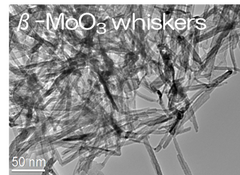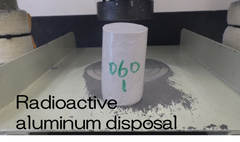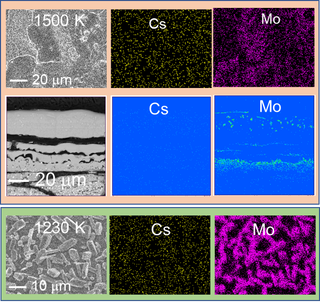Nuclear Materials
原子力材料研究

1) MoO3 Targets for Production of Medical Radioactive Isotope
For production of 99mTc by a nuclear reaction method in reactors from 98Mo, high density pettets prepared by pulsed electric current sintering (PECS) and β-MoO3 whiskers grown by PWD have been developed. Extraction of 99Mo in water utilizing the hot atom effect is carried out.
For production of 98Mo through water utilizing the hot attom effect, development of filter materials has been carried out with financial support from JKA. The report shall be uploaded on this site on Dec. 28, 2024.
Collaborators: JAEA, VINATOM, Prof. Tatsya Suzuki and Prof. Nanko, Nagaoka Univ. Tech.
医療用放射性同位元素製造のためのMoO3ター ゲットの開発
核反応法での98Moからの99mTc製造のため、PECSでの高密度 焼結やβ-MoO3ウイスカーの開発を行っています。核反応によるホットアトムを活用した水相への抽 出を行っていま す。
ホットアトムを活用したβ-MoO3からの98Moの水への抽出技術の実用 化のため、(公社)JKAの支援により透水性包装の開発を行いました。報 告書
共同研究: JAEA、VINATOM、長岡技大鈴木達也教授、南口教授
References:
Suematsu,
et al. J. Asian Ceram. Soc., 8 (2020) 1154
Chu,
et al., J. Am. Ceram. Soc., 105 (2022) 1622 (Best paper
award)
Chu,
et al., Inorganic Chem., 62 (2023) 131040
Yang,
et al., RSC Adv., 15 (2025) 17222

2) Geopolymer for Decomissioning Applicatoins
Geopolymer for hydroben recombiing catalist support and Al compaction applications have been developed to utilize its chemical stability and low production cost. Porosity control and forth element addition are carried out to enhance various properties of geopolymer.
Collaborators: ADVAN ENG co. ltd., JAEA, Kansei Gakuin Univ.
廃止措置用ジオポリマー材料開発
ジオポリマーの優れた化学的安定性と低製造コストを活用し水素再結合触媒担体用や難固化Al用のジオポリマー材料を開発し て います。気孔率制御法と第四元素添加により、ジオポリマーの特性増強を目指しています。
共同研究: アドバンエンジ(株)、日本原子力研究開発機構、関西学院大学
References:
Do,
et al., Frontiers Nucl. Eng., 4 (2025) 1699785
Yang,
et al., Jpn. J. Appl. Phys., 61 (2022) SB1003

3) Development of Cs Absorvers to Prevent Radioisotope Relese in Nuclear Severe Accidents
Cesium molybdate, Cs2MoO4 deposit on SUS304 in Ar+H2O gas at different temperatures is studied. At higher than 1500 K, Mo has diffused inside SUS, no sigh of Cs. At temperatures of about 1230 K (~ melting point of Cs2MoO4 ), Cs and Mo were found on the surface oxide of SUS.
Collaborators: JAEA
原子炉過酷事故被害低減のためのCs吸着材料の開発
Cs2MoO4をAr+H2Oガス中でステンレス鋼 に蒸着する研究を行っています。1500K以上ではステンレス鋼中にMoが拡散しますが、Csは拡散しません。Cs2MoO4の 融点近くの1230Kでは、ステンレス鋼上にMoもCsも見られます。
共同研究: JAEA
References:
Do,
et al., J. Nucl. Sci. Technol., 55 (2018) 348
Do,
et al., J. Nucl. Sci. Technol., 54 (2017) 330